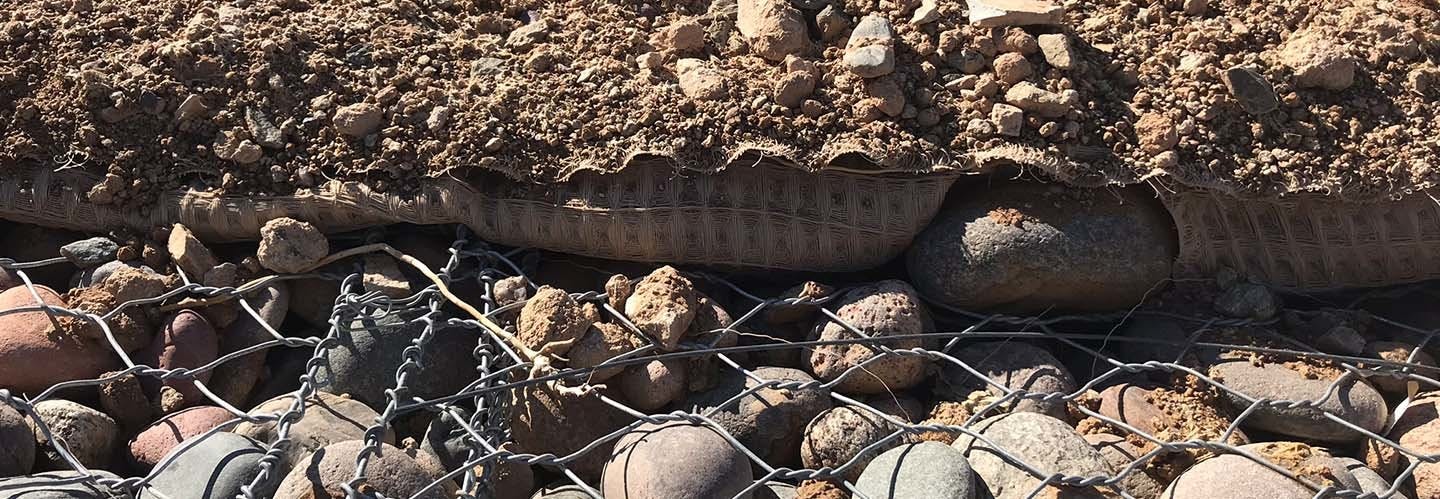Transitions and Mechanical Attachments
Posted on 7.12.2021 by Jeff Hoilman, P.E.
The majority of PYRAMAT 25 TRM and PYRAMAT 75 HPTRM installations use the recommended trenches to securely fasten the PYRAMAT to the ground at the top, toe, and lateral sides of a slope or channel. This helps prevent the material from being displaced by wind uplift and helps deter storm water from flowing beneath the material, which could potentially lead to erosion.
However, PYRAMAT can be used in conjunction with other traditional solutions and best management practices (BMPs) like concrete, rock riprap, and gabions to achieve the desired engineering outcome. At times, combing PYRAMAT with these BMPs does not allow for the installation of the trenches to securely fasten the PYRAMAT. To overcome these connection issues, Propex has developed transitional mechanical connection details to these types of BMPs. Each type of transition is discussed below in more detail.
Concrete: Connection of PYRAMAT to concrete can be accomplished in various ways by using bolts and washers, Hilti Shots, placement beneath the concrete, batten strips or a combination of these techniques. The following is a brief summary of each type of concrete mechanical connection.
Bolt Connection – This form of mechanical connection requires either the pre-installation or post-installation of bolts into concrete. Typical bolts used are three-fourth inches in diameter and spaced every two feet longitudinally. Once the bolts are installed, the PYRAMAT is cut to slide over the bolt. A 1.5-inch diameter (minimum) washer and nut are then installed and tightened to provide a secure connection. The concrete thickness should be designed based on the project’s requirements to prevent the concrete from being damaged during the installation of the bolt, and for pullout resistance. See Figures 1-3 for examples.
Figure 1: PYRAMAT Bolted Connection to Concrete Structure at Toe of Slope
Figure 2: PYRAMAT Bolted Connection to Concrete Structure
Figure 3: Example of PYRAMAT Bolted Connection to Concrete Structure
Hilti Shot Connection - This form of mechanical connection uses Hilti Shots to securely fasten PYRAMAT to the side of concrete. Additionally, this type of connection allows the concrete thickness to be less than what would be required for a bolt connection. Typically, the Hilti Shots are spaced every one foot longitudinally. See Figure 4.
Overlain Connection - This form of mechanical connection requires the PYRAMAT to be placed on the subgrade beneath the concrete area, pinned in place and the concrete poured on top of the PYRAMAT. This is often used when PYRAMAT may be adjacent to sidewalks, bike paths, and roadways. Typically, a two-foot overlap with the concrete is needed to provide a secure connection. See Figure 5.
Figure 5: PYRAMAT Overlain Connection to Concrete Structure
In some applications, it may be more feasible to extend the PYRAMAT completely beneath the concrete. See Figure 6 for an example of PYRAMAT 75 extended completely beneath a sidewalk placed in a drainage channel.
Figure 6: Example of PYRAMAT 75 Placed Completely Beneath a Sidewalk
Batten Strip - This form of mechanical connection requires the use of a metal strip, bolts, washers, and nuts. Similar to the bolt connection, bolts will be installed in the concrete on two-foot centers longitudinally. After the PYRAMAT is placed over the bolts, a metal batten strip is placed on top of the PYRAMAT. The washers and nuts are then installed to secure the batten strip and PYRAMAT to the concrete structure. This type of connection can be done on the side or the top of the concrete. See Figure 7.
Figure 7: PYRAMAT Batten Strip Connection to Concrete Structure
Gabions: The connection of PYRAMAT to gabions is very similar to concrete mechanical connections. The PYRAMAT can be either placed beneath the gabion to establish an overlap or attached to the wire gabion basket or mattress using hog rings.
Overlain Connection - This form of mechanical connection requires the PYRAMAT to be placed on the subgrade beneath the gabion basket or mattress, pinned in place, and the gabion placed on top of the PYRAMAT. Typically, a two-foot overlap with the gabion is needed to provide a secure connection. See Figure 8.
Figure 8: PYRAMAT Overlain Connection to Concrete Structure
Hog Ring Connection – The PYRAMAT is securely attached to the gabion wire basket or mattress using hog rings. The hog rings should be a minimum of 16 gauge and a one inch opening. The hog rings should be made from galvanized or stainless steel depending on the environment and design life needed. Typically the hog rings are spaced every one foot longitudinally. See Figures 9 and 10.
Figure 9: PYRAMAT Hog Ring Connection to Gabion Basket
Figure 10: Example of PYRAMAT Hog Ring Connection to Gabion Basket Example
Rock Riprap: In most applications where PYRAMAT is combined with rock riprap, the PYRAMAT is placed on the subgrade beneath the rock riprap and pinned in place. Typically, a one to two foot overlap with the rock riprap is needed to provide a secure connection. If a geotextile is being used beneath the rock riprap, the PYRAMAT should overlap the geotextile. A securing pin should be used to connect the PYRAMAT and geotextile in the overlap area. See Figures 11 and 12.
Figure 11: PYRAMAT Connection to Rock Rip-Rap
Figure 12: Example of PYRAMAT Connection to Rock Riprap
Pro Tip: It is important to have a secure connection between PYRAMAT and other BMPs to prevent wind uplift, erosion, and scour.
The connections discussed in this article are the most common type of mechanical connections used to connect PYRAMAT to other BMPs like concrete, gabions, and rock riprap. However, Propex has experience with connection to other types of BMPs to achieve the desired engineering outcome and can provide details for those connections. For more help with transitions and mechanical connections, please contact Propex Engineering Services at 423-553-2465 or email GeoEngineering@propex.vercel.app.
Interested in PFAS-Free Plastics?

